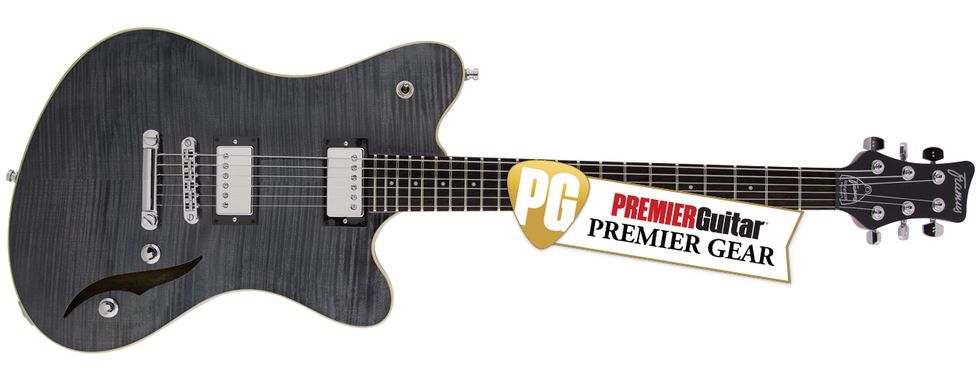Both clips played straight in to a Friedman Dirty Shirley
RatingsPros:Incredible playability. Excellent tones. Nice modern take on a vintage profile. Cons: Gigbag is a little cheap for a $3,700 guitar. Modern styling could polarize vintage-oriented players. Street: $3,699 Framus Pro Series Teambuilt Television framus.com | Tones: Ease of Use: Build/Design: Value: |
German guitar manufacturer Framus has followed an interesting arc since hitting the scene in the 1940s. The guitars the company produced between the late ’50s through its bankruptcy in the 1970s veered from solid and value-priced to archetypical Euro-guitar-design kitsch. Many, like the original Television and Strato de Luxe, ran riot with knobs and switches, chrome, and unconventional vibratos. But they were charming in their unique way, and would become prized by pawnshop-guitar aficionados.
In 1995, the Framus name was revitalized under the Warwick umbrella by founder Fred Wilfer’s son, Hans-Peter Wilfer. The instruments that ushered in the company’s new era were decidedly more upmarket than those from its past. And two decades into its rebirth, the Framus line now includes an affordable China-made D-series line, the high-end Teambuilt series made in Germany, and a range of Masterbuilt Custom Shop instruments. The new semi-hollowbody Television model pays homage to the company’s past via a borrowed silhouette from a ’60s offset offering that bore the same name. But the Teambuilt version reviewed here is a fully modernized take on the form.
TV Eye
Our demo model is light on frills, save for the stylized f-hole and a layer of cream binding that skirts the gray flame-maple top. The Teambuilt Television’s mahogany neck and back are an attractive light brown. Dot markers adorn the guitar’s rosewood fretboard. Chrome hardware appointments include GraphTech locking tuners and a TonePros Tune-o-matic bridge and tailpiece assembly, which give the Television a rock-solid feel and excellent tuning stability. Fitted with a pair of coil-tap-designed Seymour Duncan Alnico II Pro humbuckers, the Television ships from the factory with hardware and electronics that many players opt for as aftermarket upgrades. It’s also free from any finish flaws or woodworking irregularities.
On Demand
The Framus Television is inspiring to play. The chunky neck, ample 1.7" nut width, jumbo frets, and 12" fretboard radius make fretting and big bends effortless. The instrument’s fretwork is also immaculate, thanks to a turn on a Plek machine and Framus’ “invisible fretwork technology,” which keeps fret tongs hidden and edges free of any extra metal. You would be hard-pressed to find a guitar at any price with better fretwork. While the jumbo frets may puzzle players used to vintage sizes, they’re ideal for anyone with a penchant for finger vibrato and deep bends. The beautifully sculpted neck joint, which provides easy and complete access to the upper register, also contributes to the sense that the fretboard is one big playground.
Test Pattern
The Television has a unique sonic signature. The semi-hollow design retains much of the pleasant low-end attack dispersion and the woody airiness associated with most semi-hollow designs. But the guitar’s 25 1/2" scale length brings snap and twang into the picture, which infuses the highs with some Fender-y zing and rectifies some of the mushy low-end articulation that can plague 24 3/4"-scale semi-hollow guitars played through dirty amps. It’s both warm and bouncy.
The semi-hollow design also gives the Television the capacity to move from singing sustain to controllable, musical feedback that’s relatively predictable, fun to work with, and makes the guitar feel very much alive. The Duncan humbuckers are balanced and articulate, and respond nicely to volume roll-off (though I found the placement of the volume knob a bit far away for too much of that action). With volume and tone knobs and a 3-way selector switch, the control setup is efficient and relatively spartan.
The tone knob doubles as a push-pull pot to activate the coil tap, which leads to some of the Television’s most unique sounds. The single-coil output barked when mated to a dirty amp or pushed through pedals. Through my Friedman Dirty Shirley 40, it was perfect for percussive Malcolm Young-esque rhythms. It was jangly and warm through a silverface Fender Princeton Reverb. And over the course of a week of recording, the Television worked for track after track of music that required a vast range of sounds. From Telecaster twang to fuzzed-out, full-bore humbucker filth, the Television delivered.
Verdict
Most players will find the Framus Television extremely functional right out of the case. It’s an inspiring and versatile guitar. It’s German-built to high quality standards and the sonic dividends match the high price. My only real gripe is that a guitar that costs this much should come with a proper hardshell case instead of a gigbag. Though the bag provided is robust and travel-worthy, and implies the guitar is meant to be used, at nearly four grand it could ship with both.








![Rig Rundown: Russian Circles’ Mike Sullivan [2025]](https://www.premierguitar.com/media-library/youtube.jpg?id=62303631&width=1245&height=700&quality=70&coordinates=0%2C0%2C0%2C0)

















